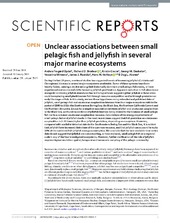| dc.contributor.author | Opdal, Anders Frugård | |
| dc.contributor.author | Brodeur, Richard D. | |
| dc.contributor.author | Cieciel, Kristin | |
| dc.contributor.author | Daskalov, Georgi | |
| dc.contributor.author | Mihneva, Vesselina | |
| dc.contributor.author | Ruzicka, James J | |
| dc.contributor.author | Verheye, Hans M. | |
| dc.contributor.author | Aksnes, Dag Lorents | |
| dc.date.accessioned | 2020-04-15T11:21:28Z | |
| dc.date.available | 2020-04-15T11:21:28Z | |
| dc.date.issued | 2019-02-28 | |
| dc.Published | Opdal AF, Brodeur RD, Cieciel, Daskalov G, Mihneva V, Ruzicka, Verheye HM, Aksnes DL. Unclear associations between small pelagic fish and jellyfish in several major marine ecosystems. Scientific Reports. 2019;9:2997 | eng |
| dc.identifier.issn | 2045-2322 | en_US |
| dc.identifier.uri | http://hdl.handle.net/1956/21866 | |
| dc.description.abstract | During the last 20 years, a series of studies has suggested trends of increasing jellyfish (Cnidaria and Ctenophora) biomass in several major ecosystems worldwide. Some of these systems have been heavily fished, causing a decline among their historically dominant small pelagic fish stocks, or have experienced environmental shifts favouring jellyfish proliferation. Apparent reduction in fish abundance alongside increasing jellyfish abundance has led to hypotheses suggesting that jellyfish in these areas could be replacing small planktivorous fish through resource competition and/or through predation on early life stages of fish. In this study, we test these hypotheses using extended and published data of jellyfish, small pelagic fish and crustacean zooplankton biomass from four major ecosystems within the period of 1960 to 2014: the Southeastern Bering Sea, the Black Sea, the Northern California Current and the Northern Benguela. Except for a negative association between jellyfish and crustacean zooplankton in the Black Sea, we found no evidence of jellyfish biomass being related to the biomass of small pelagic fish nor to a common crustacean zooplankton resource. Calculations of the energy requirements of small pelagic fish and jellyfish stocks in the most recent years suggest that fish predation on crustacean zooplankton is 2–30 times higher than jellyfish predation, depending on ecosystem. However, compared with available historical data in the Southeastern Bering Sea and the Black Sea, it is evident that jellyfish have increased their share of the common resource, and that jellyfish can account for up to 30% of the combined fish-jellyfish energy consumption. We conclude that the best available time-series data do not suggest that jellyfish are outcompeting, or have replaced, small pelagic fish on a regional scale in any of the four investigated ecosystems. However, further clarification of the role of jellyfish requires higher-resolution spatial, temporal and taxonomic sampling of the pelagic community. | en_US |
| dc.language.iso | eng | eng |
| dc.publisher | Springer | en_US |
| dc.rights | Attribution CC BY | eng |
| dc.rights.uri | http://creativecommons.org/licenses/by/4.0/ | eng |
| dc.title | Unclear associations between small pelagic fish and jellyfish in several major marine ecosystems | en_US |
| dc.type | Peer reviewed | |
| dc.type | Journal article | |
| dc.date.updated | 2019-11-15T11:45:53Z | |
| dc.description.version | publishedVersion | en_US |
| dc.rights.holder | Copyright 2019 The Author(s) | en_US |
| dc.identifier.doi | https://doi.org/10.1038/s41598-019-39351-7 | |
| dc.identifier.cristin | 1721092 | |
| dc.source.journal | Scientific Reports | |

